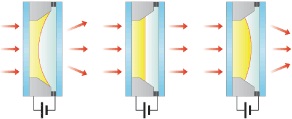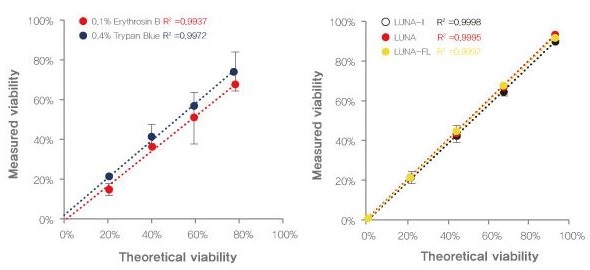The LUNA-II™ automated cell counter has integrated a novel focusing mechanism based on liquid lens technology. The liquid lens does not use any mechanical moving parts to change the Z stage. Instead, the Z position of the sample is rapidly obtained by the application of a small voltage to the liquid lens.
The elimination of moving parts removes noise and significantly reduces the need for servicing. Even after multi-million cycles of focusing, the liquid lens does not require repair or service. In combination with this novel focusing mechanism, the LUNA-II™ has integrated a new autofocusing algorithm optimized for cell counting.

Cell counting accuracy: de-clustering
The LUNA-II™ automated cell counting algorithm has been recognized to have the best-in-class cell counting accuracy. The LUNA™ software has exceptional accuracy in cell de-clustering and can successfully count clumpy cells.
The LUNA-II™ automated cell counter has inherited this well-known performance aspect of the LUNA™ software. Clumpy cells are de-clustered quickly and automatically, then counted as individual cells.
Erythrosin B and Trypan blue-compatible
Although the LUNA-II™ can detect and count unstained cells, viability information can only be obtained from stained cell solutions. The traditional trypan blue can be used with the LUNA-II™, as well as the safer Erythrosin B. Both dyes produce consistently accurate cell count and viability data with the LUNA-II™.

Left: A comparison of viability data using Trypan Blue and Erythrosin B.
Right: Viability data using Erythrosin B with the LUNA-II, LUNA, and LUNA-FL.
Read the following article for more information on Erythrosin B-stained cell viability data: “Application of a non-hazardous vital dye for cell counting with automated cell counters”.
Reduced running cost
Automated cell counters utilize disposable counting slides to eliminate washing steps of manual cell counting with the glass hemocytometer. Although disposable cell counting slides have several advantages, the increased running cost has been a substantial concern.
Logos Biosystems developed a patented T-BOND technology to manufacture precision cell counting slides more efficiently. Therefore, the unit price of counting slides became much more affordable, providing significant cost savings.
Built – in printer
A thermal printer is integrated in the LUNA-II™ automated cell counter, and the counting results can be printed immediately for record keeping purposes. Because the printer is already integrated in the LUNA-II™ automated cell counter, an additional cable connection is not required.

Interactive software interface
Options for staining methods
The LUNA-II™ automated cell counter can count samples with or without trypan blue dye. The selection of trypan blue presence or absence can easily be chosen in the settings menu.
Cell size histogram and cell size based gating
After counting, cells can be gated based on their size information provided by the LUNA-II™. The specific size of cell populations Can easily be included or excluded on histograms.
Cell cluster map
Counted cells can be sorted with cell cluster map, into single cells, doublets, or triplets. The cell cluster map can be used to monitor changes in culture conditions or cell isolation/preparation protocols.
Review and Re-analysis option
The LUNA-II™ automated cell counter provides a powerful review option. A separate PC unnecessary. Users can open cell images directly on the LUNA-II™ automated cell counter to check previous results.
Various file save options
The LUNA-II™ can store up to 1,000 counts onboard. After counting, the result is automatically saved in the memory, and previous count results can be exported via USB as a .CSV file for further analysis.
The results and image data can be saved in three different file formats such as TIF, annotated TIF, or a PDF report file. The PDF report file contains all the data generated during/after the cell counting, i.e., the protocol used, cell counting results, date, raw/analyzed cell image(s), and histograms are included in the PDF report file.